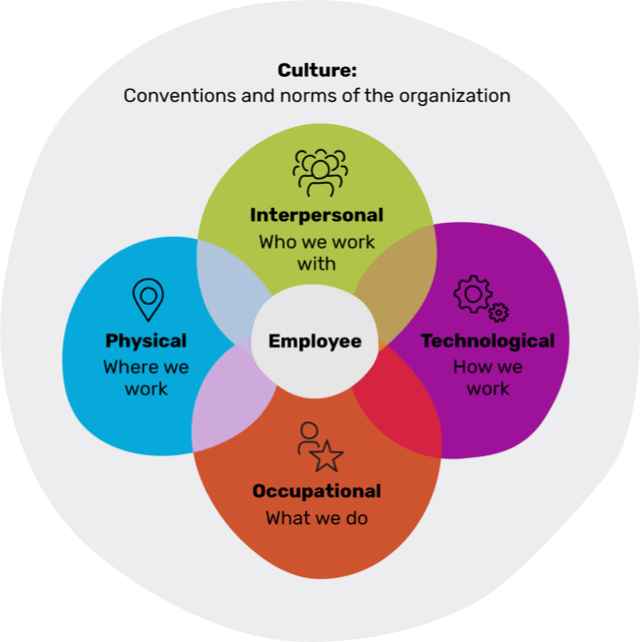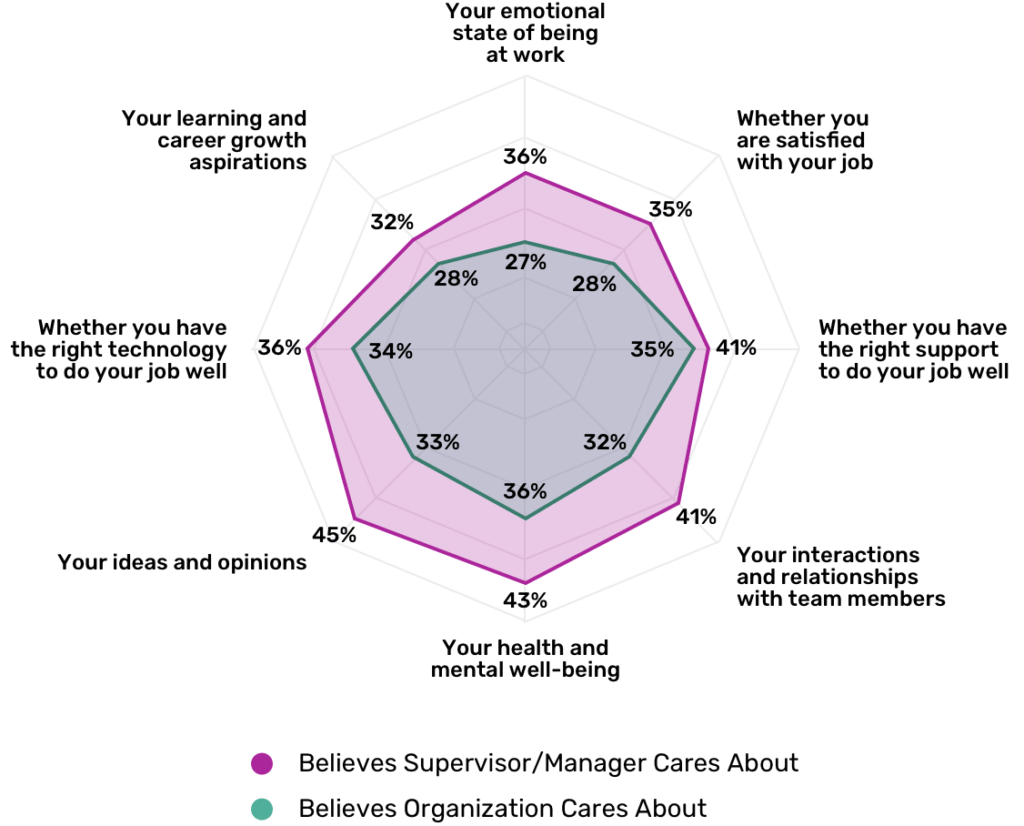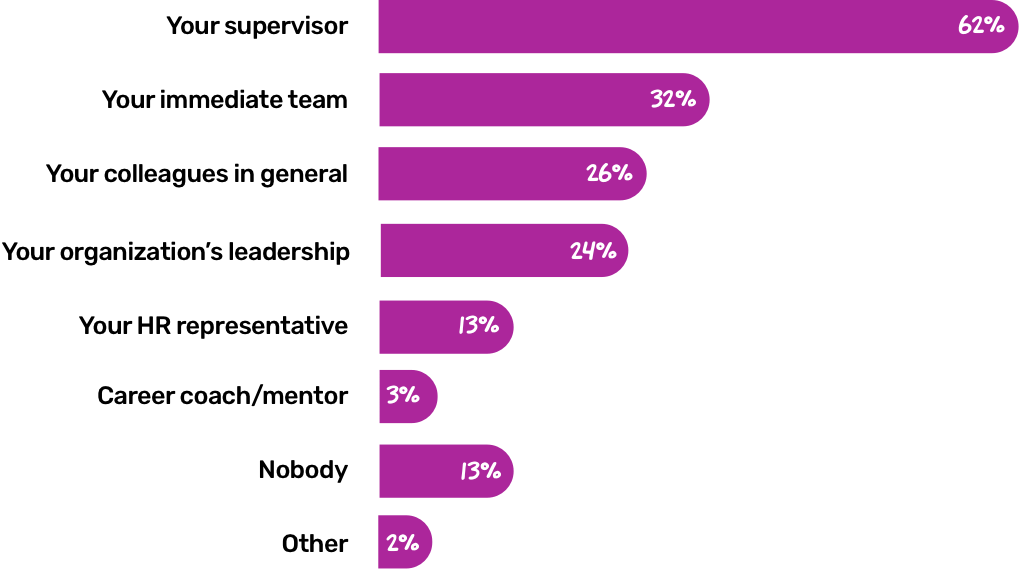Report
Improve the employee experience: Guide to creating exceptional employee experiences

Momentous work-life changes push employee experience front and center
One out of every four employees nationally says their day-to-day work experience worsened during the COVID-19 pandemic. Despite the stark deterioration, only 25% of employees said that their organizations took greater action to improve employee experience (EX) over customer experience during the past year, according to a recent survey by Eagle Hill Consulting of more than 1,000 U.S. employees across a variety of industries.
Why improving the employee experience matters
Eagle Hill Consulting’s recently published study of the state of the customer experience revealed how employee experience drives customer experience. Specifically, a bad employee experience negatively impacts employees’ productivity, their ability to serve customers, the delivery of quality outcomes—even their fundamental willingness to help others. In other words, employee experience strikes at the bottom line.
Moreover, at a time when more than half of employees (53%) report feeling burnt out at work and jobs reports are trumpeting the difficulty organizations across industries have been having filling roles, a top-notch employee experience equates to competitive advantage. As recently noted in Forbes, “Until the coronavirus pandemic completely upended the economy, few workers were in a position where they could demand the benefits they wanted or choose to leave a job that was treating them so badly. Now there are more people with not only the bargaining power to get what they want but also the motivation to ask for it.”
Defining the employee experience
Organizations may struggle to get EX right because they mistake EX with related (but not all-encompassing) concepts, such as engagement, benefits, performance management, and so on. EX is broader; it’s how employees think and feel about their day-to-day interactions within an organization.
Moreover, the shift to hybrid work and working from home in recent years has upended traditional ideas about EX. Once employees turned their homes into offices, organizations gained a host of new challenges related to delivering positive EX outside of their traditional boundaries.
The Eagle Hill model for exceptional EX considers four factors that influence employees, shown in Figure 1: Interpersonal (who we work with), Occupational (what we do), Physical (where we work), and Technological (how we work).
Our report uncovers the employee experience trends organizations need to address immediately to facilitate an exceptional employee experience.
Figure 1. The Eagle Hill Model for Exceptional Employee Experience

Source: Eagle Hill Consulting
Learn more about our Employee Experience Model
Employee Experience Trend #1
Employees want to feel their employers “have their backs”
Our survey reveals that currently, 87% of national respondents say they are satisfied with their overall work experience. Forty-one percent say they are very satisfied. Employees most highly value work-life balance and purposeful work, with 29% and 17% of respondents respectively ranking these as their most valued factor.
Despite the seemingly sanguine outlook, however, one out of every two employees (53%) surveyed say they have considered leaving their jobs in the past year. More than a quarter (29%) of respondents said they would leave if offered a comparable position elsewhere with similar pay and benefits (Figure 2).
That’s more than one out of every four. Twenty-one percent think their jobs will be outsourced to lower-cost contract workers in the near future, and 17% think their jobs will be replaced by tech automation or bots.
Figure 2. More than 1 in 4 employees would leave their current jobs if offered a comparable position elsewhere.
I would stay at my organization even if I were offered a comparable position elsewhere with similar pay and benefits.

Source: Eagle Hill Consulting Employee Experience Survey 2021
The signals of potential turnover that Eagle Hill sees in these results may reflect employees’ own impressions of their employers’ lack of commitment. As organizations worked through unprecedented challenges of supporting employees both logistically and emotionally during COVID-19, any missteps along the way may have had an unusually large impact on their vulnerable and sensitive employees, leaving those employees primed to make an exit.
Employee Experience Trend #2
Employees want more help to get ready for a rapidly changing future
Compounding the sense of uncertainty employees feel, the nature of work across industries faces drastic change. According to the Forrester Research article Predictions 2021: COVID Wrote The Business Case — Our Future Is Digital, “the pandemic changed everything… [in 2019], 85% of firms viewed digital as nice to have. In 2020, every company learned that digital is critical to customer and business success.”
Many employees do not feel ready for the digital future. When asked if their organizations were training them with what they need for the future, 38% of respondents in our survey said they are not confident they are getting the right skills training for the future. In fact, a significant number believe they need more drastic intervention than simply some added training: nearly 1 in 3 (30%) say they feel the need to be reskilled. Interestingly, male respondents were considerably more likely (36%) than females (22%) to say they need to be reskilled. And young millennials, despite their advantage of having been raised in a digital society, were more than twice as likely as boomers (36% versus 16%) to feel they needed to be reskilled.
Figure 3. Employees’ perceptions of their future opportunities reflect the uncertainties of the recent past.
How would you rate your overall experience with the following?

Source: Eagle Hill Consulting Employee Experience Survey 2021
Following our first employee experience trend, employees clearly worry about their place in the future. Against the backdrop of dramatic political and civic upheaval and rapid technology advances, employees have learned that, in the parlance of the finance industry, past career results are no guarantee of future performance. In fact, nearly one third (32%) of all respondents have a negative impression of their promotion opportunities, and slightly over a quarter (27%) have a negative impression of their career path opportunities (Figure 3).
With competition coming from all corners, even employees who have historically had a comfortably defined path forward now feel threatened. Organizations must take a more active and vocal role in defining how their employees figure into their future—or risk their valuable employees leaving.
Employee Experience Trend #3
Employees want and expect to feel cared for (but are being let down)
How employees think or feel about their day-to-day work interactions defines their experience; therefore, organizations must demonstrate a recognition that how their employees feel has real consequences. Yet our survey shows that too few organizations have taken this crucial step.
For example, more than 1 out of 2 (51%) respondents disagree that they are being mentored for success. As they flounder toward an uncertain future, employees have sought a helping hand—that isn’t there. In fact, less than half (41%) of employees say their supervisor/manager demonstrates care about whether they have the right support to do their job well, and only 36% say their supervisor/manager demonstrates care about whether they have the right technology to do their job well.
Across the board, supervisors/managers and organizations received dismal feedback on how well they provide a range of emotional supports that are critical to an excellent employee experience. Eagle Hill looked at eight factors; for not one factor did a majority of respondents agree that their supervisors/managers or their organizations demonstrate care or concern (Figure 4).
Employee attitudes may herald an even larger problem. According to the 2021 State of the Manager report from Glint and LinkedIn, manager burnout rose 78% between Q1 and Q4 of 2020. Findings such as these indicate that supervisors/managers themselves feel stretched beyond their limits today, likely with little left over for employee care.
Figure 4. Employees appear unimpressed with the level of care and concern their supervisors, managers, and organizations demonstrate.
Do your supervisor/manager and your organization demonstrate care and concern about the following?

Source: Eagle Hill Consulting Employee Experience Survey 2021
Employee Experience Trend #4
Employees want flexibility where and when they work
Across generations, respondents have mixed sentiments about the return to the physical workplace. Overall, 6 out of 10 employees (57%) in our survey agree that teleworking has been a positive experience.
Where, when, and how employees work in the future remain big questions for organizations to answer. On one hand, in-person (in the office) interactions among employees drive innovation, collaboration, camaraderie, and connection to the culture and broader organization. On the other hand, the traditional model restricts employees’ flexibility in their personal lives. That’s a point that can’t be dismissed; as a case in point, a recent survey of more than 2,800 Americans by human resources (HR) consulting firm Robert Half found that 23% of workers have quit a job because of a bad commute.
Today, as more organizations are returning to the office, they must still consider the pros and cons and carefully balance what makes sense for their business. Many workers want to maintain some work-from-home flexibility and need the right technology capabilities. At the same time, formal office settings must remain environments where people can collaborate and thrive.
The gap in employee experience efforts today
As our findings show, what employees expect of their employers and their experience has rapidly shifted since COVID-19, social change, new technologies, and more. Those changes will continue with new market shifts and new generations of employees. The foundation for addressing EX issues is understanding them. Yet, the results of our survey indicate that organizations may only have a rudimentary grasp of the challenges employees face.
When asked how their organizations measure employee engagement and satisfaction, for example, 26% of respondents say their organization doesn’t measure employee engagement and satisfaction at all. When they do measurements, organizations leave many opportunities for in-the-moment information on the table. For example, only 35% say they have ongoing conversations about their engagement and satisfaction, and just 17% say their organization employs periodic surveys to “take a pulse” of the employee experience.
Organizations must think about improving EX as more than an HR problem. In fact, it will take a concerted effort across the business. Employees already understand this fact. We asked employees who they believe is accountable for their employee experience, and only 13% said HR. In contrast, 62% said their supervisor was accountable and 32% said it was their immediate team (Figure 5). In other words, out of the hands of HR, EX truly becomes an organization-wide responsibility.
Figure 5. Employees don’t view employee experience as an HR responsibility.
Who is accountable for your employee experience at your organization?

Source: Eagle Hill Consulting Employee Experience Survey 2021
Takeaways
Where should organizations start on the critical work of improving EX at a time when it matters more than ever but is even harder to get right?

Think beyond human resources. Human resources may head all EX efforts; some organizations may even have a dedicated EX officer, but EX is a cross-functional undertaking. For example, when an employee’s computer breaks down, when an employee achieves a major milestone on their project/workstream, or when an employee must work remotely while taking care of a sick parent or a child at home—how an organization handles these circumstances will color the employee experience. In other words, the moments that matter to employees aren’t limited to what’s within HR’s control. A cross-functional committee can help create a connected and consistent EX across the organization and ensure that leaders outside of HR fully understand their responsibility and capacity to improve EX.

Organize EX around what actually matters to employees. Too often, organizations jump into EX planning and initiatives without first considering what employees want. Applying human-centered design techniques allows organizations to better empathize with the employee, capturing their experiences, feelings, and thoughts to understand what bright spots and issues they have when it comes to different aspects of EX.
We recommend not only surveying employees and engaging them in diverse, cross-functional focus groups for honest and open conversation, but also “spending a day in their shoes.” Incorporating a wealth of input from different sources (such as the voice of the employee, journey maps, experience maps, best practices, and more), leaders from HR, operations, IT, and other relevant functions should lay out a plan to tackle EX from various angles.

Focus on the middle to enact your employee experience strategies. Organizations frequently implement EX in a top-down fashion, even though employees consistently point to their direct teammates and immediate supervisors as being accountable for their employee experience. When implementing EX strategies, supervisors and managers need to contribute to the plan and be made to understand their role and responsibilities in bringing the plan to life consistently across the business. Making supervisors and managers such an integral part of the EX improvement process will require strong change management and communication practices, as well as metrics to assess performance.

Create feedback loops to align tech change with people’s needs. Organizations should seek to incorporate employee input and feedback to identify what technology would be most helpful to increase productivity and success. Companies should also ensure that continuous feedback structures exist to solicit feedback and act on it as appropriate. The experience of providing feedback should be transparent, not intimidating or complicated. After all, having direct input into designing the technology can increase the technology’s likelihood of being adopted.

Reengage, reassess, reiterate. If life after the pandemic has taught us anything, it’s that our external circumstances are always changing, influencing how we feel about our work any given day. As organizations develop their EX strategies amid great upheaval, they should engage employees in their planning and assess existing initiatives. Then, they must communicate across the business so that business leaders and supervisors are in the know and employees trust that companies have their best interests in mind.
The work of EX never ends. Organizations must maintain a continuous pulse on the state of EX so that they can reassess how employees feel and whether their EX initiatives continue to contribute to a positive experience. When they don’t, it’s time to take corrective action.
Methodology
The Eagle Hill Consulting Employee Experience Survey 2021 was conducted online by Ipsos in January 2021. The survey included 1,003 respondents from a random sample of employees across the United States. The survey polled respondents on employee experience aspects, including technology, diversity, employee engagement, and customer service.

